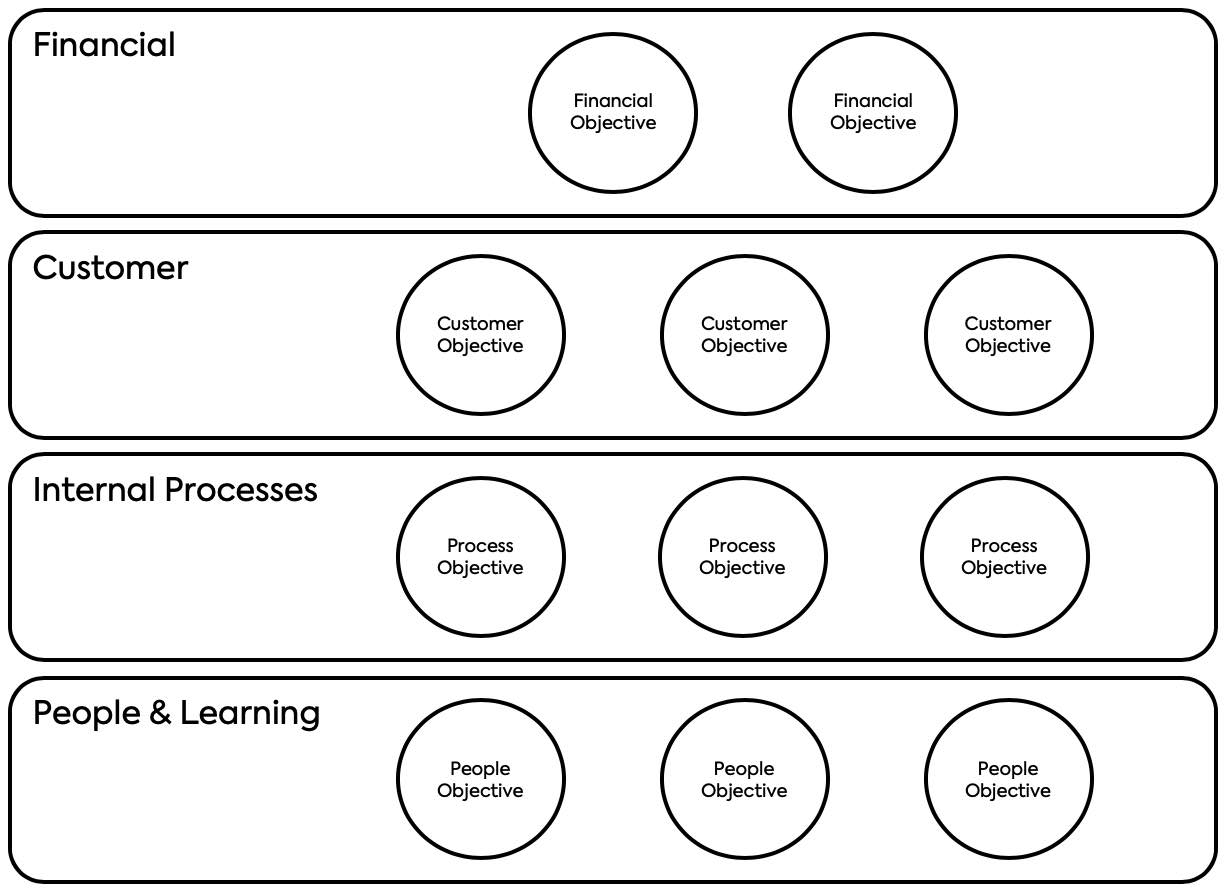There are many ways to communicate a strategic plan, often attempting to condense a great deal of thinking into a one pager. The Strategy Map is one such framework, and is used by companies to have a snapshot summary of their strategic plan.
What is the Strategy Map?
A Strategy Map is a single page diagram that explains a strategy’s objectives. It’s used for communicating out strategic summaries for employees within a company.
Strategic Objectives are listed out under four categories:
- Finance
- Customer
- Internal Processes
- People & Learning
Each Objective on the map has links, so you can quickly see how the different objectives support each other. As a tool, the Strategy Map is used for communicating out strategic summaries for employees within a company and for sanity checking your strategic plans.
Finance:
There are fairly common KPIs used within Financial, such as revenue or profitability. These are the top-level objectives around what you’re trying to achieve from an economic perspective. Some considerations are:
- What are your revenue targets?
- What is your profitability target?
- What are your cost targets?
Customer:
A really important aspect of your strategic plan is around your customer objectives. It might be to focus on loyalty, customer expectations or product. Some considerations for this section are:
- Price and quality of product or service
- Availability and service of product or service
- Loyalty and ongoing customer engagement
- Customer satisfaction levels?
- If you’re a non-profit, consider your beneficiaries at this stage
Ultimately this level is about your Customer Value Proposition. These are all objectives that will impact your Financial goals directly. For example, how does customer lifetime value impact your revenue? It may be helpful to read our guide to customer service KPIs at this point.
Processes:
Now we’re into the section of the map that charts your internal processes as a business. This is where profitability really comes into play, your objectives here will all impact one way or another how profitable and efficient you are as a company. Consider the following:
- Supply chain and supplier impact
- Current process for creating/delivering product or service
- Relationships with customers and stakeholders
- Compliance processes around areas such as Health and Safety or GDPR
- Innovation to improve or diversify your offering
- Overall operational efficiency and process
This layer covers a lot, as we touch on not only product and your current processes, but also how you innovate and offer a continued successful product. Keep in mind that these are all objectives that support your customer goals, which ultimately support your financials.
People & Learning:
Critical to any successful business or non-profit is the people and employees. Any good strategy has to have objectives around their team, focusing on areas such as reward, development and recognition. Consider the following:
- Culture and creativity
- Learning and development
- Org and team structures to support the company
- Market knowledge and awareness
- Interaction between employees and customers
- Core values of company and employee engagement
Your people will support your operational objectives, which allow your customer objectives, which enable your financial objectives. Like a version of the “Dem Bones” song but for strategy… 🤦
What are the advantages of a Strategy Map?
A Strategy Map is designed to communicate a strategy so has a number of advantages:
- It can help employees engage and understand strategic direction
- It can align teams to the same goals
- It shows you how your different objectives are related
What are the limitations of a Strategy Map?
The main disadvantages of the approach are:
- It needs other tools as there’s no market data capture
- It’s often done once and can be forgotten about
- Although it’s a "one pager" for communication, it is not that engaging for employees
- There’s no progress illustrated on a basic Strategy Map – you need to combine it with something like strategy software or a Balanced Scorecard.
- It focuses on the what rather than the why
What are the alternative tools to a Strategy Map?
The best alternative to a Strategy Map would be generating your communication within a tool like Lucidity! Boom! But in terms of frameworks, an alternative to the Strategy Map framework would be the Strategy Diamond.
What preparation should be done before using a Strategy Map?
A Strategy Map is usually done once a strategy is fully formulated or a lot of the background work is done, but can be a great way to sanity check your thinking.
Who invented the Strategy Map?
Robert S. Kaplan and David P. Norton in the mid to late 1990s first used Strategy Maps in conjunction with the Balanced Scorecards.
How often does a company’s Strategy Map get used?
A Strategy Map can be used as an ongoing reminder of your strategy or when a strategy is reviewed. Remember though you will need to be more engaging than a Strategy Map to excite your team.
If you’re looking for ways to communicate your strategic plan then take a look at the Lucidity platform for ongoing, innovative and engaging ways to share with and get feedback from your team.
Easily make your strategy clear and accessible
Book a demo and we'll show you how our strategy software will give your strategy one central home, bring it to life and get everyone onboard.












